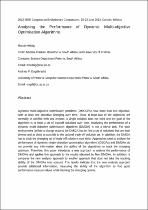JavaScript is disabled for your browser. Some features of this site may not work without it.
- ResearchSpace
- →
- Research Publications/Outputs
- →
- Conference Publications
- →
- View Item
| dc.contributor.author |
Helbig, M

|
|
| dc.contributor.author |
Engelbrecht, AP

|
|
| dc.date.accessioned | 2013-08-21T12:45:39Z | |
| dc.date.available | 2013-08-21T12:45:39Z | |
| dc.date.issued | 2013-06 | |
| dc.identifier.citation | Helbig, M and Engelbrecht, A.P. 2013. Analysing the performance of dynamic multi-objective optimisation algorithms. In: 2013 IEEE Congress on Evolutionary Computation, 20-23 June 2013, Cancún, México | en_US |
| dc.identifier.uri | http://ieeexplore.ieee.org/stamp/stamp.jsp?tp=&arnumber=6557744 | |
| dc.identifier.uri | http://hdl.handle.net/10204/6945 | |
| dc.description | 2013 IEEE Congress on Evolutionary Computation, 20-23 June 2013, Cancún, México. Published in IEEE Xplore. | en_US |
| dc.description.abstract | Dynamic multi-objective optimisation problems (DMOOPs) have more than one objective, with at least one objective changing over time. Since at least two of the objectives are normally in conflict with one another, a single solution does not exist and the goal of the algorithm is to track a set of tradeoff solutions over time. Analysing the performance of a dynamic multi-objective optimisation algorithm (DMOA) is not a trivial task. For each environment (before a change occurs) the DMOA has to find a set of solutions that are both diverse and as close as possible to the optimal trade-off solution set. In addition, the DMOA has to track the changing set of trade-off solutions over time. Approaches used to analyse the performance of dynamic single-objective optimisation algorithms (DSOAs) and DMOAs do not provide any information about the ability of the algorithms to track the changing optimum. Therefore, this paper introduces a new approach to analyse the performance of DMOAs and applies this approach to the results obtained by five DMOAs. In addition, it compares the new analysis approach to another approach that does not take the tracking ability of the DMOAs into account. The results indicate that the new analysis approach provide additional information, measuring the ability of the algorithm to find good performance measure values while tracking the changing optima. | en_US |
| dc.language.iso | en | en_US |
| dc.publisher | IEEE Xplore | en_US |
| dc.relation.ispartofseries | Workflow;11367 | |
| dc.subject | Dynamic multi-objective optimisation problems | en_US |
| dc.subject | DMOOP | en_US |
| dc.subject | Dynamic multi-objective optimisation algorithm | en_US |
| dc.subject | DMOA | en_US |
| dc.title | Analysing the performance of dynamic multi-objective optimisation algorithms | en_US |
| dc.type | Conference Presentation | en_US |
| dc.identifier.apacitation | Helbig, M., & Engelbrecht, A. (2013). Analysing the performance of dynamic multi-objective optimisation algorithms. IEEE Xplore. http://hdl.handle.net/10204/6945 | en_ZA |
| dc.identifier.chicagocitation | Helbig, M, and AP Engelbrecht. "Analysing the performance of dynamic multi-objective optimisation algorithms." (2013): http://hdl.handle.net/10204/6945 | en_ZA |
| dc.identifier.vancouvercitation | Helbig M, Engelbrecht A, Analysing the performance of dynamic multi-objective optimisation algorithms; IEEE Xplore; 2013. http://hdl.handle.net/10204/6945 . | en_ZA |
| dc.identifier.ris | TY - Conference Presentation AU - Helbig, M AU - Engelbrecht, AP AB - Dynamic multi-objective optimisation problems (DMOOPs) have more than one objective, with at least one objective changing over time. Since at least two of the objectives are normally in conflict with one another, a single solution does not exist and the goal of the algorithm is to track a set of tradeoff solutions over time. Analysing the performance of a dynamic multi-objective optimisation algorithm (DMOA) is not a trivial task. For each environment (before a change occurs) the DMOA has to find a set of solutions that are both diverse and as close as possible to the optimal trade-off solution set. In addition, the DMOA has to track the changing set of trade-off solutions over time. Approaches used to analyse the performance of dynamic single-objective optimisation algorithms (DSOAs) and DMOAs do not provide any information about the ability of the algorithms to track the changing optimum. Therefore, this paper introduces a new approach to analyse the performance of DMOAs and applies this approach to the results obtained by five DMOAs. In addition, it compares the new analysis approach to another approach that does not take the tracking ability of the DMOAs into account. The results indicate that the new analysis approach provide additional information, measuring the ability of the algorithm to find good performance measure values while tracking the changing optima. DA - 2013-06 DB - ResearchSpace DP - CSIR KW - Dynamic multi-objective optimisation problems KW - DMOOP KW - Dynamic multi-objective optimisation algorithm KW - DMOA LK - https://researchspace.csir.co.za PY - 2013 T1 - Analysing the performance of dynamic multi-objective optimisation algorithms TI - Analysing the performance of dynamic multi-objective optimisation algorithms UR - http://hdl.handle.net/10204/6945 ER - | en_ZA |






